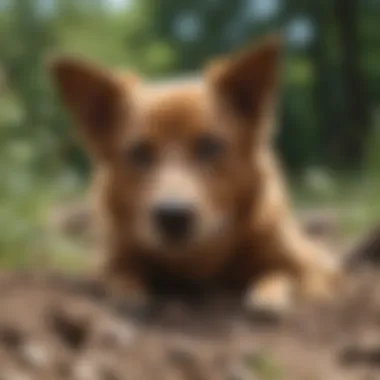Stop Your Dog from Digging: Practical Solutions


Intro
Understanding why dogs dig holes is crucial for pet owners. This behavior may stem from various factors, including breed tendencies, environmental influences, and potential health issues. By identifying the underlying reasons, owners can implement effective strategies to mitigate this behavior. In this article, we will examine the reasons and discuss practical solutions.
Animal Overview
Common Name and Scientific Classification
Dogs, known scientifically as Canis lupus familiaris, have been companions to humans for thousands of years. They belong to the Canidae family, which also includes wolves, foxes, and other canids.
Physical Characteristics
Dogs exhibit a wide range of physical traits. They vary greatly in size, coat texture, and color. For example, a Great Dane stands tall at over thirty inches, while a Chihuahua may only reach a height of six inches. Their physical diversity contributes to their ability to adapt to different environments.
Habitat and Distribution
Dogs are found in various habitats around the world. They adapt well to both urban and rural settings. Domesticated dogs typically live in human homes, where they provide companionship and security.
Understanding Digging Behavior
Reasons Dogs Dig
Common reasons for digging include:
- Instinctual behavior: Some breeds, like terriers, have a strong digging instinct.
- Boredom and anxiety: A lack of physical and mental stimulation can lead to unhealthy behaviors.
- Hunting and exploration: Dogs may dig to uncover scents or small animals.
- Seeking comfort: Sometimes dogs dig to create a secure space.
It's important for owners to recognize these triggers to address the behavior effectively.
Redirecting Energy
One way to reduce digging is by redirecting a dog's energy into productive activities. Engaging in regular exercise and mental stimulation can greatly alleviate boredom. Activities may include:
- Daily walks or runs.
- Interactive toys that challenge their problem-solving skills.
- Training sessions that reinforce commands and good behavior.
Behavioral Interventions
Practical Solutions
To mitigate digging, owners can:
- Create a digging zone: Designate a specific area in the garden where digging is allowed.
- Use deterrents: Apply safe deterrents to areas where digging is problematic. Citrus scents or pepper can be effective.
- Increase supervision: Keeping an eye on your dog can prevent unwanted digging behaviors before they start.
Professional Help
If digging persists despite efforts, seeking help from a professional dog trainer or behaviorist may be beneficial. These experts can provide tailored strategies to address the specific needs of each dog.
Closure
Dog digging can be a challenging behavior for many owners. By understanding the reasons behind this instinct, and implementing strategies to redirect their energy, dog owners can create a more harmonious living environment. Addressing these instincts with patience and consistency will ultimately yield positive results for both the dog and the owner.
Understanding the Digging Behavior of Dogs
Dogs dig for various reasons, rooted deeply in their nature and upbringing. Understanding these behaviors is crucial for pet owners. By doing so, you can tailor your approach to effectively reduce this habit, ensuring a more harmonious relationship.
The Evolutionary Background of Digging
Digging is an instinctive behavior traced back to wild canines. In their natural habitats, dogs dug to create burrows for safety and comfort. They also dug to find prey and compost for food. This behavior was essential for survival. Even today, many breeds retain these instincts, influencing their actions. Understanding this historical context helps owners recognize that digging is often a biological drive, not just mischief.
Typical Reasons Dogs Dig
Several reasons contribute to this digging habit.


- Boredom: Dogs may dig out of sheer boredom. Without enough stimulation, they resort to excavating the yard.
- Stress and Anxiety: When a dog feels anxious or threatened, digging can offer comfort or escape.
- Exploration: Curiosity leads dogs to explore their environment. Digging offers them a chance to discover and interact.
- Territorial Instinct: Some dogs will dig to mark their territory or respond to changes in their environment.
Identifying these triggers is essential for addressing unwanted digging.
Digging by Breed: What You Should Know
Different dog breeds possess unique digging tendencies. Some are more prone to dig than others due to their original functions. For example:
- Terriers: Bred for hunting, they have a strong instinct to dig, often pursuing burrowing animals.
- Collies: This breed may dig out of boredom or stress.
- Scent hounds: Bred for tracking, they often dig to follow scents.
Knowing your dog's breed can provide insight into their digging behavior. This understanding allows for implementing the right strategies.
Understanding the nature of your dog's digging behavior is the starting point for solving this common issue. By applying focused strategies, you can redirect this energy into more constructive activities.
Identifying Causes of Digging in Your Dog
Understanding the reasons behind your dog's digging behavior is crucial in addressing the issue effectively. Many owners will often view digging as a troublesome habit without undertaking an investigation into its root causes. Identifying the specific triggers allows for targeted intervention. This enhances the dog's quality of life and creates a more harmonious environment at home. Ignoring the problem only leads to frustration and potentially deepening the behavior.
Boredom as a Trigger
Boredom is one of the most prevalent causes of digging. Dogs that lack sufficient physical activity and mental engagement will often resort to digging as a means of amusement. Dogs are social animals that thrive on stimulation. When they do not receive enough exercise or playtime, they might create their own entertainment, which can manifest in digging.
Signs of boredom can include:
- Excessive barking
- Chewing on furniture
- General lethargy between bursts of energy
Addressing boredom involves introducing a more active lifestyle. Ensure daily walks, playtime, and perhaps engage in games that challenge the dog mentally. Toys that dispense treats can also provide incentive, keeping the dog occupied and less likely to dig.
Anxiety and Stress Responses
Anxiety can trigger digging behavior in various forms. A dog experiencing separation anxiety may dig around doors or windows, attempting to escape and reach their owner. Fearful or stressed dogs, whether from loud noises, new environments, or changes in family dynamics, may dig as a coping mechanism. Understanding the dog's anxiety triggers is key.
The impact of this behavior might not just be destructive but can also indicate the dog's emotional wellbeing.
- Observe body language for signs of stress.
- Providing a safe space where the dog feels secure can mitigate anxiety.
Techniques such as gradual desensitization to the anxiety source should be considered, alongside distractions during stressful events.
Curiosity and Exploration
Dogs are naturally curious beings. They like to explore their environment. It’s not uncommon for them to dig if they sense something interesting underneath the ground, such as small animals or even the scent of food. This instinctual behavior is particularly noticeable in breeds with strong hunting characteristics.
Encouraging appropriate exploration is important. Rather than punishing the digging, redirect this curiosity positively. Designed digging areas may satisfy their instinct while keeping them contained and safe.
Mating Behavior and Territorial Instincts
Certain breeds will dig as part of mating behavior or to mark territory. Dogs mark their territory with scents, and digging can be a part of that process. Female dogs in heat may dig more than males, while territorial digging can be observed when strange animals or new people appear in the vicinity.
Awareness of these natural behaviors allows owners to set boundaries without punishing the dog. Providing proper training and managing the environment can alleviate issues stemming from these instincts.
Understanding these underlying issues will significantly assist in formulating the right strategies to resolve digging behavior. It is essential to observe attentively and approach the situation with a mindset aimed at improvement rather than punishment.
Practical Strategies to Stop Digging
Addressing your dog's digging behavior is crucial for creating a harmonious environment. Practical strategies can help you redirect this instinctual behavior into positive activities. More than just curbing unwanted digging, these strategies can lead to a stronger bond between you and your pet. They also promote mental and physical well-being for your dog.
Increasing Physical Activity
A lack of physical exercise can often lead dogs to dig. Dogs that do not receive enough exercise might resort to digging as an outlet for their pent-up energy. Increasing physical activity is a straightforward strategy that can mitigate this issue. Regular walks, running, or playtime in the yard helps satisfy your dog's need for movement.
Consider incorporating interactive games into your routine. Games like fetch, tug-of-war, or agility courses not only burn energy but also stimulate their minds. Such play can keep dogs physically engaged and reduce their desire to dig.
Providing Mental Stimulation


In addition to physical activity, mental challenges are vital for dogs. Boredom is a prominent factor that leads to unwanted behaviors, including digging. Providing mental stimulation can significantly reduce this tendency. Puzzles, treat-dispensing toys, or training sessions can engage your dog's brain in meaningful ways.
Additionally, taking time for training commands and tricks keeps your dog focused. This focus can be an alternative to digging. Moreover, mental exercise can tire your dog out just as much as physical activity does.
Establishing a Designated Digging Area
Sometimes, digging is a natural behavior. Instead of completely prohibiting it, consider creating a designated digging area. This space allows your dog to dig freely without causing damage to your garden or yard. Choose a spot away from valuable plants or structures. Fill this area with loose soil or sand to make it inviting.
Encourage your dog to use this area by burying toys or treats. This way, they can satisfy their digging instinct in an acceptable way. It also provides a controlled environment for digging, reducing the temptation to dig elsewhere.
Utilizing Training Techniques
Positive Reinforcement
Positive reinforcement focuses on rewarding desired behaviors rather than punishing unwanted ones. This method fosters a trusting relationship between you and your dog. By giving praise, treats, or toys when your dog refrains from digging, you encourage them to repeat that behavior.
Its main appeal lies in its effectiveness and simplicity. Positive reinforcement establishes clear communication and helps your dog understand what behavior is appreciated. Though sometimes it requires consistent application and patience, the long-term benefits make it worthwhile.
Redirecting Attention
Redirecting attention involves catching your dog in the act of digging and distracting them with a different activity. This strategy combines physical and mental engagement. When your dog begins to dig, redirect their focus to a toy or another activity, such as play or training.
This technique is beneficial because it doesn’t rely on negative consequences. Instead, it promotes positive interactions. Dogs respond better when they know what actions are preferred instead of just feeling reprimanded.
Command Training
Command training is another effective strategy to reduce digging. Teaching your dog commands such as
Environmental Modifications
Environmental modifications are crucial in curbing the digging behavior of dogs. Understanding how the surroundings can influence your dog's actions allows you to create a space that minimizes undesirable behaviors. A well-considered outdoor environment not only keeps the dog engaged but also reduces the likelihood of digging. This section will detail specific additions and changes that can be implemented to create a more dog-friendly yard.
Creating a Dig-Proof Yard
Designing a dig-proof yard involves several strategies that can effectively deter a dog from digging holes. First, consider using underground barriers made of wire mesh or fencing. This addition can prevent dogs from accessing the soil below and keep them from tunneling. Ensure these barriers are buried a few inches deep to enhance effectiveness.
Next, you can cover the yard with materials that dogs find unappealing. Options include using decorative rocks, gravel, or other items that are uncomfortable for paws. This solution does not mean you should completely give up on grass and softer areas. Instead, establish designated digging zones that can serve as alternatives for your dog to satisfy their instinct while keeping the rest of the yard intact.
Moreover, incorporating landscape features like flower beds, bushes or fences can redirect your dog's attention. Adding sensory elements to the area can stimulate curiosity without the need for digging. Plants with strong scents or textures that dogs find intriguing can suffice. Importantly, regular supervision and engagement during outdoor play can help ensure that your dog remains focused on positive activities rather than digging.
Maintaining a Secure Outdoor Space
Maintaining a secure outdoor space is imperative in preventing digging behavior. Regularly inspect your yard for any potential escape routes or areas that encourage digging. It's essential to fix any gaps in fences or sections where the soil has become loose or disturbed.
Creating a routine for supervision is another critical aspect. When dogs are left alone for extended periods, they may resort to digging out of boredom or anxiety. Ensuring that your outdoor space is safe and engaging includes the use of toys, tunnels, or even play equipment that directs your dog’s energy positively.
Additionally, keep the yard clean and free of distractions like trash, old toys, or any other items that may entice your dog to dig. A tidy environment reduces the likelihood of unwanted digging behavior. By reinforcing a secure and engaging outdoor space, you foster a healthier relationship with your dog and limit their inclination to dig.
Maintaining a dog's mental and physical engagement is key to reducing unwanted behaviors like digging. Regular activities and safe environments encourage positive interactions.
In summary, effective environmental modifications entail creating a dig-proof yard and maintaining a secure outdoor space. A comprehensive approach that focuses on both deterring behaviors and engaging with the dog can lead to significant improvements.
Health Considerations
Understanding health considerations is crucial when addressing your dog's digging behavior. While digging can often be attributed to boredom, anxiety, or instinct, in some cases, it can signal underlying health issues. Recognizing the physical and emotional well-being of your dog is paramount. Ignoring these signals may lead to further behavioral problems or worsen any existing health concerns.
Benefits of addressing health considerations include:
- Early diagnosis of potential medical conditions.
- Improved overall well-being of your dog.
- Development of a more appropriate intervention strategy.
When assessing a dog's digging habits, owners should take note of any changes in behavior. These could be indicative of discomfort or distress, necessitating further investigation.


When Digging Signals Health Issues
Dogs may dig due to various reasons, including instinctual behaviors and mental stimulation. However, when this behavior becomes excessive or sudden, it may point to health issues.
Common health-related factors include:
- Pain or Discomfort: If a dog is experiencing pain, they may dig to try and find comfort. For instance, a dog with joint pain may dig to create a more comfortable resting spot.
- Nausea: Dogs sometimes dig when they feel nauseous. The act may help them to feel more secure or relieve discomfort.
- Dermatological Issues: Skin problems can prompt digging as dogs try to alleviate itchiness or irritation.
- Changes in Appetite or Behavior: If digging is sudden, and it coincides with changes in appetite or overall activity level, a medical examination is wise.
Keeping an eye on these indicators allows owners to make informed decisions regarding their pet’s health.
Consulting with a Veterinarian
Consultation with a veterinarian is advisable if a dog's digging behavior raises concerns about potential health issues. This professional insight helps identify any underlying conditions that need to be addressed.
When scheduling a veterinary appointment, it is beneficial to present detailed observations, including:
- The frequency and duration of the digging.
- Any associated behaviors, such as loss of appetite or lethargy.
- Changes in your dog's environment or routine that may coincide with digging.
During the consultation, the veterinarian may conduct a physical exam and possibly recommend tests to rule out health problems.
Working closely with a veterinarian not only helps in diagnosing potential issues but also in formulating a comprehensive treatment plan, should any health concerns arise. Regular check-ups are vital for ensuring your dog’s long-term health and well-being.
It's always better to address health concerns early than to find out too late that the issue was more serious than anticipated.
Behavioral Modification Approaches
Behavioral modification is a vital part of managing your dog's digging behavior. Understanding how to influence and change this instinctual action leads to more effective interventions. It offers a means to address not just the symptoms of digging, but also the deeper issues that may drive this behavior. This approach focuses on creating new habits and modifying existing ones, promoting a more harmonious relationship between you and your pet.
Understanding and Managing Anxiety
Anxiety can significantly contribute to a dog's digging habits. Many dogs dig due to fear, loneliness, or past trauma. A better comprehension of these emotional triggers allows owners to develop effective strategies to alleviate anxiety.
Identifying signs of anxiety in your dog is the first step. Common indicators include excessive barking, pacing, or destructive behavior. Once you recognize these signs, you can take specific actions to help your dog manage their anxiety. Here are several strategies to consider:
- Routine Establishment: Keeping a consistent daily schedule helps dogs feel more secure.
- Safe Spaces: Providing a comfortable area where your dog can retreat for safety can reduce anxiety levels.
- Calm Interaction: Use soothing tones and gentle reassurances to create a comforting environment.
- Professional Help: If anxiety continues, consulting with a veterinarian or a qualified animal behaviorist may be necessary.
Gradual Desensitization Techniques
Gradual desensitization is a useful method to help dogs overcome anxiety-related digging. This technique involves exposing your dog to anxiety-inducing stimuli in a controlled and gradual manner. The goal is to help them adapt to these triggers without fear.
For example, if your dog digs when left alone, you can begin by leaving them for short periods, gradually increasing the duration as they become more comfortable. The following steps can assist in implementing this technique:
- Identify Triggers: Recognize what situations cause your dog to dig.
- Controlled Exposure: Expose your dog to these situations in a safe manner, starting small.
- Positive Reinforcement: Reward your dog for remaining calm during these exposures to reinforce desirable behavior.
- Monitoring Progress: Keep records of your dog’s reactions to document improvements and adjust your approach if needed.
The key to success with gradual desensitization lies in patience and consistency.
By embracing behavioral modification approaches, you can address the root causes of your dog's digging and create a healthier, more enjoyable environment for both you and your pet.
Concluding Thoughts
Understanding the complexities surrounding a dog’s digging behavior is crucial for pet owners. This article has explored various dimensions of this instinctive act, highlighting not only the reasons why dogs dig but also effective strategies to curb this behavior. Recognizing the various triggers—ranging from environmental factors to physical and mental stimulation—provides a foundation for any intervention aimed at reducing excessive digging.
The Importance of Patience and Consistency
The journey to modify a dog's digging habits requires a significant investment in patience and consistency. Immediate results are rarely the norm when addressing behavioral issues with pets. It is vital for dog owners to maintain a steady approach throughout the training process.
Consistency in commands, routines, and expectations helps the dog understand what behaviors are acceptable. Over time, this repetition builds a clear framework for the dog, reinforcing learning. It is advisable to reward positive behavior to promote good habits. For example, if your dog plays in the designated area instead of digging holes, a treat or praise can strengthen this behavior.
Without patience, frustration may lead to ineffective training methods, which can confuse the dog further. To achieve lasting change, owners must cultivate an environment that nurtures growth and understanding.
Creating a Healthier Bond with Your Dog
A behavior like digging may seem troubling, but it can also serve as an opportunity to strengthen the bond between dog and owner. Open lines of communication, both verbal and non-verbal, foster trust and understanding.
Engaging in activities that stimulate both body and mind is pivotal. This could mean longer walks, interactive toys, or even dog training classes. Such actions not only redirect digging instincts but also provide an avenue for reinforcing the relationship. Building this connection enhances the dog’s sense of security, likely leading to a reduction in anxiety-driven digging.
Ultimately, the aim is to encourage the dog to seek companionship and constructive outlets instead of inappropriate digging. An engaged dog is less likely to engage in unwanted behaviors, as they will find satisfaction and fulfillment in their interactions with their owner.
In summary, adopting a methodical approach while nurturing your dog’s emotional well-being creates a more harmonious environment for both pet and owner.







